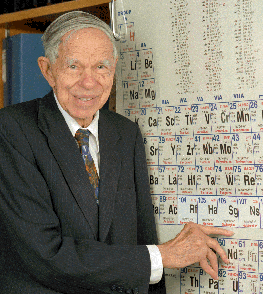

ELEMENT 106, WHICH WAS CREATED AT LBL in 1974 and confirmed here last summer, has been named "seaborgium" in honor of Nobel Laureate and LBL Associate Director-at-Large Glenn T. Seaborg. It is the first time an element has been named for a living person.
"This is the greatest honor ever bestowed upon me--even better, I think, than winning the Nobel Prize," said Seaborg, the co-discoverer of plutonium and nine other transuranium elements. "Future students of chemistry, in learning about the periodic table, may have reason to ask why the element was named for me, and thereby learn more about my work."

Glenn Seaborg points out seaborgium on the periodic table
The name seaborgium, with its chemical symbol of "Sg," was announced at the 207th national meeting of the American Chemical Society in San Diego. The announcement was made by Kenneth Hulet, retired chemist from Lawrence Livermore National Laboratory (LLNL) and one of the co-discoverers of seaborgium.
Seaborgium is the newest name to be added to the family of "transuranium" elements--those beyond uranium on the periodic table. Uranium, element 92, is the heaviest known naturally-occurring element. The transuranium elements can be artificially created in particle accelerators. Seaborgium has a half-life of less than a second. It was first created and identified in 1974 in an experiment conducted at LBL by a team of LBL and LLNL researchers led by Hulet and LBL physicist Albert Ghiorso.
It was finally confirmed in 1993 in an experiment at LBL's 88-inch Cyclotron led by Ken Gregorich. The team included Gregorich and LBL faculty senior scientist Darleane Hoffman, plus postdoctoral fellows and students from LBL and the UC Berkeley Department of Chemistry.
Seaborg is perhaps best known for his role in the discovery of plutonium. This took place in 1940, when Seaborg, McMillan, Joseph Kennedy, and Arthur Wahl, using a 60-inch cyclotron built by Ernest Lawrence, bombarded a sample of uranium with deuterons and transmuted it into plutonium. Seaborg and his co-workers used the discovery of plutonium as a stepping stone to the creation of a succession of transuranium elements--americium, curium, berkelium, californium, einsteinium, fermium, mendelevium, nobelium, and now seaborgium.
It was Seaborg who in 1944 formulated the "actinide concept" of heavy element electronic structure which predicted that the actinides, including the first 11 transuranium elements, would form a transition series analogous to the rare- earth series of lanthanide elements. Called one of the most significant changes in the periodic table since Mendeleev's 19th century design, the actinide concept showed how the transuranium elements fit into the periodic table and paved the way for future discoveries.
In 1951 Seaborg shared the Nobel Prize in chemistry with former LBL Director Edwin McMillan for "their discoveries in the chemistry of the transuranium elements."
Seaborg holds more than 40 patents, including the only ones for a chemical element (americium and curium). He is the author of numerous books and more than 500 scientific articles. He has been awarded 50 honorary doctoral degrees and is recognized as a national advocate for science and math education.
Born in 1912 in Ishpeming, Michigan, Seaborg received a Ph.D. in chemistry from UC Berkeley in 1937. He joined the UCB faculty in 1939 and served as chancellor from 1958 to 1961. From 1961 through 1971 he served as chairman of the Atomic Energy Commission (predecessor of the U.S. Department of Energy) under U.S. Presidents Kennedy, Johnson, and Nixon. He then returned to research at Berkeley and to LBL, where he continues today in his search for new elements and isotopes.
Return to LBL Research Review Table of Contents